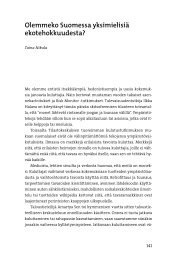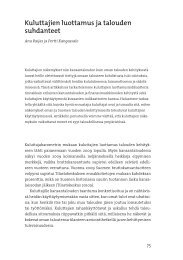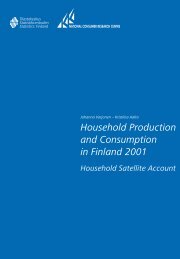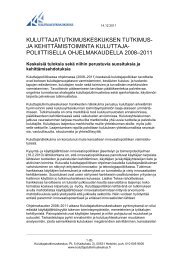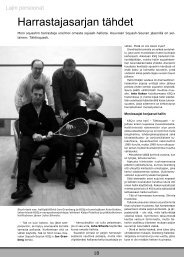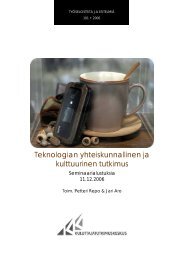Household Production and Consumption in Finland 2001
Household Production and Consumption in Finland 2001
Household Production and Consumption in Finland 2001
You also want an ePaper? Increase the reach of your titles
YUMPU automatically turns print PDFs into web optimized ePapers that Google loves.
In other calculations shown <strong>in</strong> this report, the value of labour is determ<strong>in</strong>ed<br />
on the basis of gross hourly wages exclud<strong>in</strong>g employer’s social <strong>in</strong>surance<br />
contributions. In that case unpaid work accounts for 39 per cent of GDP. If<br />
work done by children aged 10–14 were added to the 1990 figures, the GDP<br />
proportion would be around 46 per cent. In spite of m<strong>in</strong>or differences <strong>in</strong> the<br />
calculations, we may observe that there are only m<strong>in</strong>or, but positive, changes<br />
<strong>in</strong> the extent of household production <strong>in</strong> comparison with the rest of the<br />
economy.<br />
The F<strong>in</strong>nish result, which shows m<strong>in</strong>or positive change <strong>in</strong> the value of<br />
unpaid work as a proportion of GDP from 1990 to <strong>2001</strong>, is <strong>in</strong> sharp contrast to<br />
<strong>in</strong>ternational trends. Although the absolute value of unpaid work has gone up<br />
<strong>in</strong> all countries, many have reported a decrease <strong>in</strong> its share of GDP over the<br />
past ten years. This suggests that the growth of other production has outpaced<br />
household production, or that wages <strong>in</strong> jobs equivalent to unpaid work have<br />
developed more slowly than other wages. In Germany the value of unpaid<br />
work as a proportion of GDP <strong>in</strong> 1992 was 52 per cent, <strong>in</strong> <strong>2001</strong> the figure was<br />
down to 48 per cent (net wages). In the Basque Country, correspond<strong>in</strong>gly, the<br />
figures were 49 per cent <strong>in</strong> 1993, 39 per cent <strong>in</strong> 1998 <strong>and</strong> 33 per cent <strong>in</strong> 2003.<br />
In Australia, the value of unpaid work <strong>in</strong> 1992 was 51 per cent <strong>and</strong> <strong>in</strong> 1997 43<br />
per cent of the country’s GDP (Schäfer 2004, Basque Statistics Office 2004,<br />
Trew<strong>in</strong> 2000).<br />
One possible reason why the value added of household production <strong>in</strong><br />
F<strong>in</strong>l<strong>and</strong> has changed relatively little is that the proportion of people out of<br />
work <strong>and</strong> outside the labour force has <strong>in</strong>creased sharply from 1990 to <strong>2001</strong>. It<br />
has been discovered that unemployed persons do more unpaid work than<br />
those <strong>in</strong> wage employment. Another possible explanation is that <strong>in</strong> the<br />
countries just mentioned, women moved <strong>in</strong>to wage employment <strong>in</strong> greater<br />
numbers <strong>in</strong> the 1990s than was the case <strong>in</strong> F<strong>in</strong>l<strong>and</strong>, where the correspond<strong>in</strong>g<br />
change happened earlier.<br />
The structure of production has changed somewhat. Although calculations<br />
for 1990 <strong>and</strong> <strong>2001</strong> are not fully comparable, it is <strong>in</strong>terest<strong>in</strong>g to exam<strong>in</strong>e the<br />
relationship between labour, the consumption of fixed capital <strong>and</strong><br />
<strong>in</strong>termediate consumption.<br />
Structure of production <strong>in</strong> non-SNA production, % of total output<br />
1990 <strong>2001</strong><br />
Value of labour 76.4 74.2<br />
Taxes m<strong>in</strong>us subsidies – 0.9<br />
<strong>Consumption</strong> of fixed capital 2.2 4.1<br />
Intermediate consumption 21.4 20.8<br />
Value of output 100.0 100.0<br />
34 Statistics F<strong>in</strong>l<strong>and</strong> National Consumer Research Centre




